If you’ve ever stared at empty apartment walls thinking, “This needs more green,” you’re in the right place.
Hanging planters have completely revolutionized how we Indian apartment dwellers bring nature indoors—especially when floor space feels more precious than gold.
The best plants for hanging planters indoors aren’t just pretty decorations—they purify air, survive irregular watering schedules, and actually thrive in everything from Mumbai’s intense monsoon humidity to Delhi’s harsh dry winters.
I started my hanging plant journey three years ago in my 650 sq ft Mumbai flat. What began with a single money plant has now transformed into a 15-plant vertical garden that’s genuinely changed how my home feels. The air feels noticeably fresher, those boring walls look alive, and honestly? Watering my hanging plants every morning has become the most peaceful part of my daily routine.
This comprehensive guide shares everything I genuinely wish someone had told me when I started: which plants survive irregular watering when you’re traveling, how to properly adjust care through India’s different seasons, common beginner mistakes that killed my first three plants, and Instagram-worthy styling tricks that make every visitor ask questions.
Let’s turn those empty corners and bare walls into beautiful cascading green spaces together.
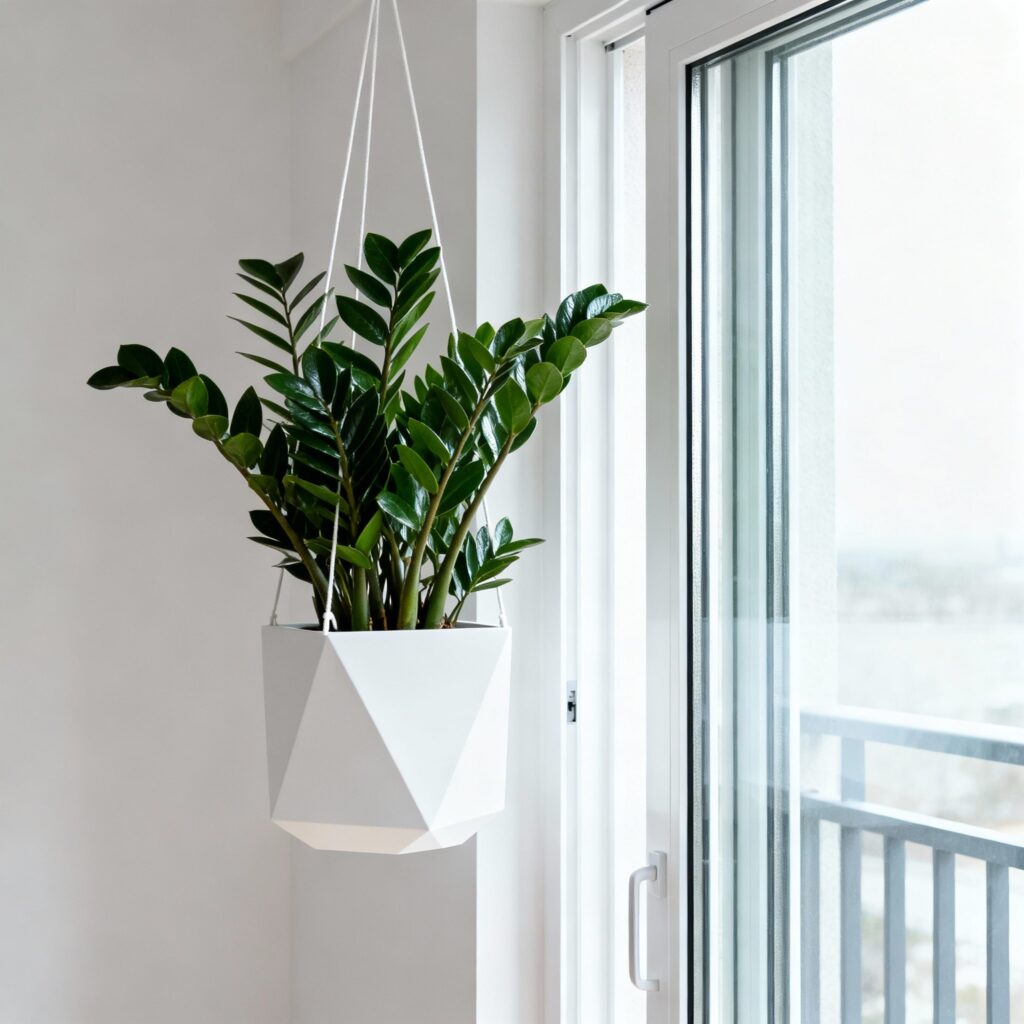
Quick Plant Comparison: Choose Your Perfect Match
| Plant Name | Light Requirement | Watering | Ideal Location | Difficulty |
|---|---|---|---|---|
| Money Plant | Low to Bright Indirect | Weekly | Bathroom, bedroom, living room | Beginner |
| Spider Plant | Bright Indirect | Twice weekly | Near windows, balcony doors | Beginner |
| String of Pearls | Bright Indirect | Every 10-12 days | Covered balcony | Intermediate |
| Boston Fern | Medium to Bright | 2-3 times weekly | Humid areas, bathroom | Intermediate |
| Portulaca | Full Sun (6-8 hours) | Daily in summer | South/west balcony | Beginner |
| ZZ Plant | Low Light | Every 2-3 weeks | Dark corners, offices | Beginner |
| Philodendron | Low to Medium | Weekly | North-facing rooms | Beginner |
| Petunia | Full Sun (5-6 hours) | Daily | Sunny balconies | Intermediate |
Which Plant is Best for Hanging Pots? Understanding the Basics
Here’s something I learned the hard way: not every plant actually enjoys being suspended in mid-air. My very first attempt with a jade plant ended badly—it was way too top-heavy and kept tipping over.
The best plants for hanging planters indoors share several specific traits:
Trailing growth habit is absolutely non-negotiable. Plants like pothos, philodendrons, and string of pearls naturally cascade downward, creating that gorgeous waterfall effect without constant pruning. I’ve personally watched my money plant grow over 6 feet long in just 18 months.
Light flexibility literally saves lives. Since hanging positions often mean indirect or filtered light, choose varieties that genuinely tolerate low to medium brightness levels. My bathroom money plant gets maybe 2 hours of indirect morning light daily and still thrives beautifully.
Forgiving nature matters more than beginners realize. Hanging planters dry out significantly faster than regular floor pots because of increased air circulation. When I travel for work, my drought-tolerant string of pearls and ZZ plant survive beautifully for 10-12 days.
Air-purifying ability is an incredible bonus. According to NASA’s Clean Air Study, spider plants and English ivy actively remove harmful toxins like formaldehyde and benzene from your indoor air. My bedroom spider plant has produced so many baby plantlets that I’ve gifted them to half my apartment building.
Compact root systems adapt significantly better. Plants with shallow or moderate root systems handle limited soil volume in hanging containers much better. I repot my hanging plants only once every 18-24 months, compared to floor plants that need annual repotting.
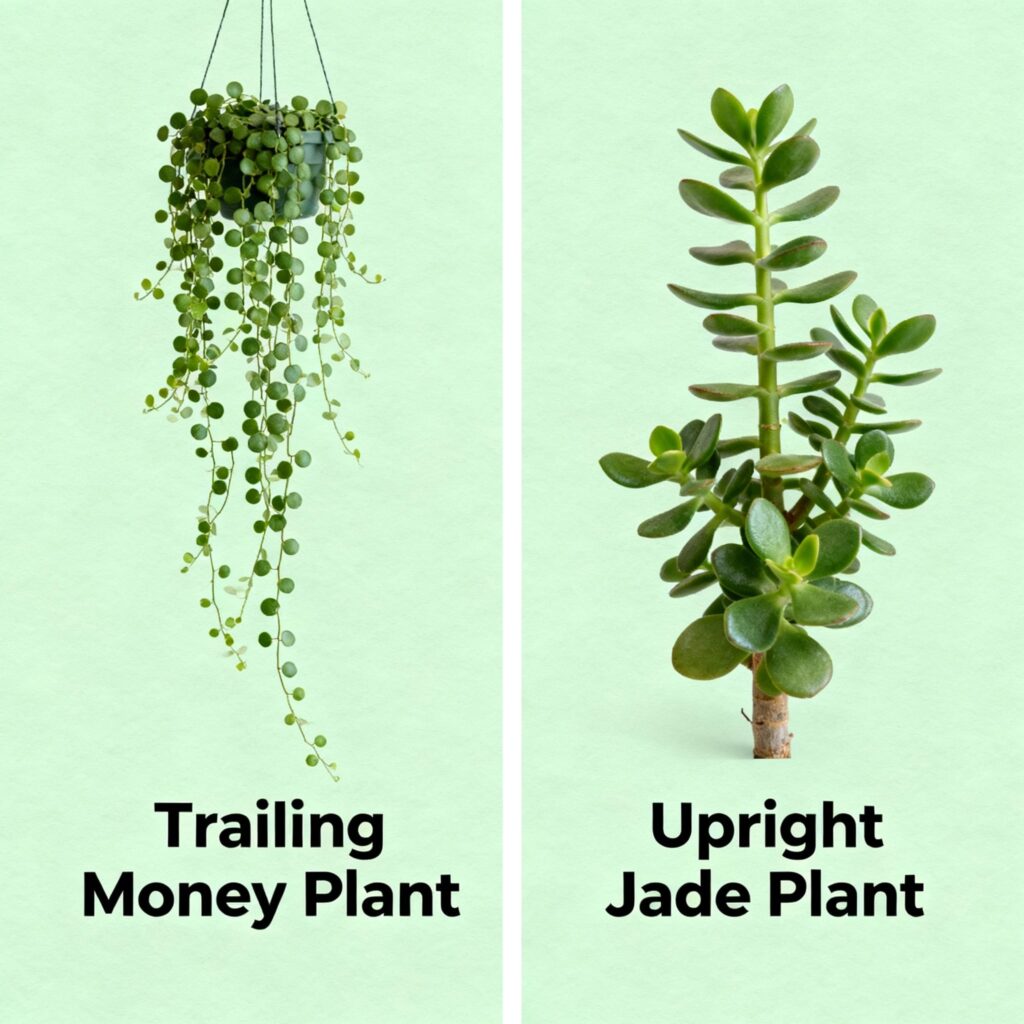
The real secret? Always match the plant perfectly to your specific light conditions. I successfully grew vibrant portulacas on my south-facing balcony with 7 hours of direct sun, and simultaneously grew healthy money plants in my north-facing bathroom corner with minimal light. Both thrived because they were genuinely placed in their happy environments.
Season-Wise Plant Selection for Indian Climate
Understanding India’s dramatic seasonal changes completely transformed my hanging plant success rate.
Summer Survivors (March-June)
When temperatures hit 40°C, only specific hanging plants survive.
Portulaca became my absolute summer hero. These cheerful flowering plants actually bloom MORE in extreme heat. I water mine once daily in the early morning, and they reward me with stunning pink, yellow, and orange flowers every morning. The secret? They’re succulents at heart, storing water in their fleshy leaves.
String of pearls looks like natural jewelry cascading down. These succulent beads need bright indirect light and watering just once every 10-12 days during summer.
ZZ plant genuinely handles everything summer throws at it—AC-less rooms, dry air, inconsistent watering.
Care hack: Always water full-sun plants very early morning (6-7 AM). Afternoon watering means half the water evaporates before reaching the roots.
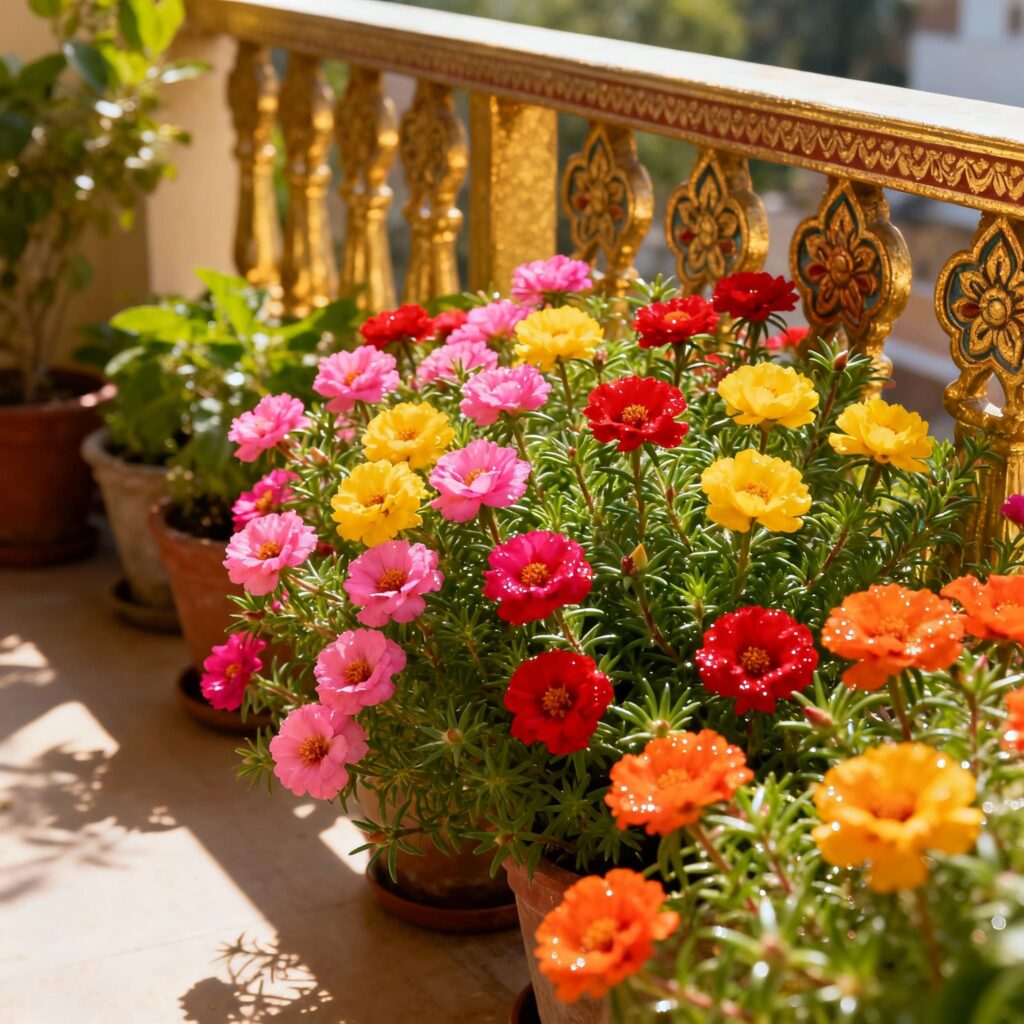
Monsoon Bloomers (June-September)
Mumbai monsoon taught me that high humidity is both a blessing and a curse.
Spider plants become complete growth machines during the monsoon. The natural 70%+ humidity perfectly mimics their native tropical environment. My spider plant produced 12 baby plantlets during one monsoon season!
Boston ferns look absolutely lush when the monsoon hits. I don’t even miss them during these months because the air moisture is perfect. They grow 3x faster than any other season.
Money plant vines grow so rapidly during the monsoon that I need monthly trimming. I’ve propagated over 20 healthy cuttings from my original plant, all rooted successfully during the monsoon months.
Critical mistake I made initially: Overwatering during the monsoon killed three of my early plants. The soil stays moist naturally from humidity—adding your regular watering schedule causes root rot. Now I check soil moisture before EVERY watering by inserting my finger 2 inches deep. If it feels even slightly damp, I skip watering entirely.
Important note: My succulents struggled with excess humidity until I moved them to my covered balcony, where air circulation was better.
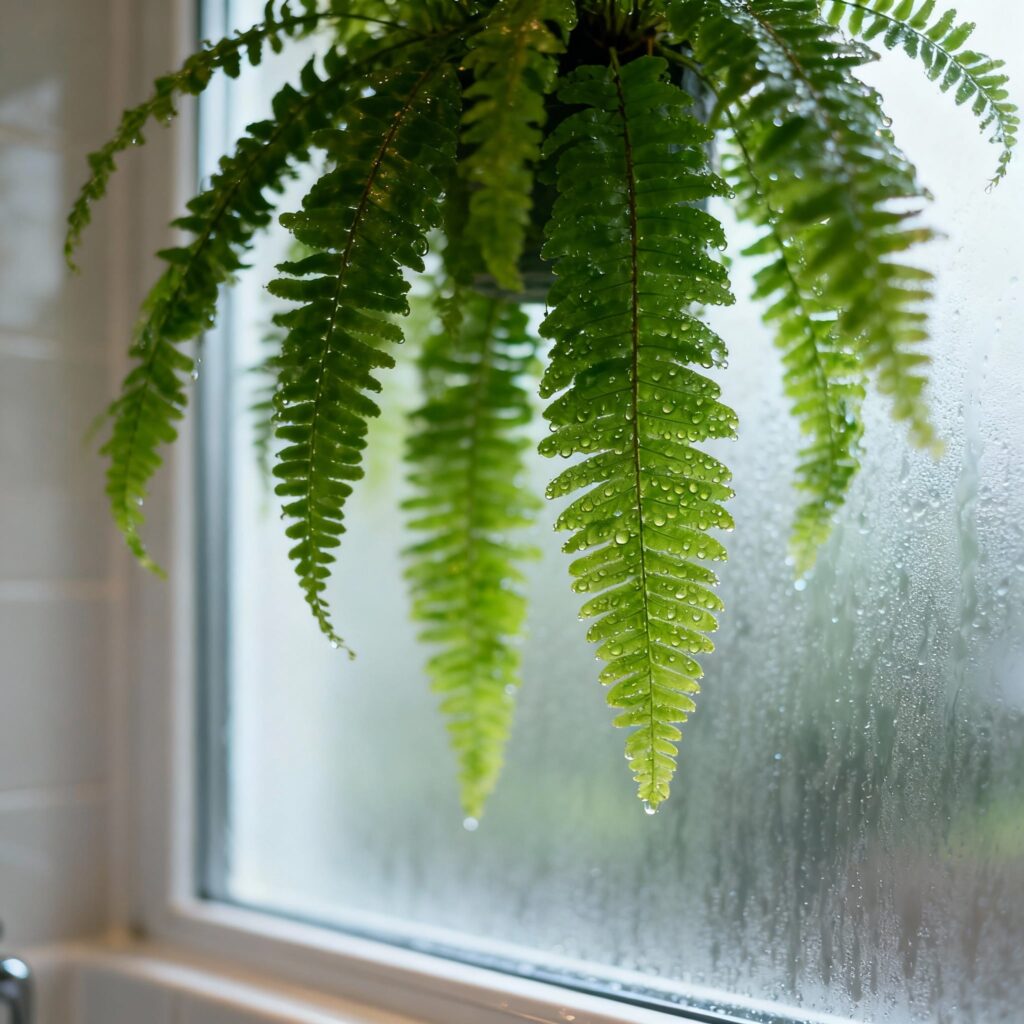
Winter Wonders (October-February)
Cool, dry winters suit flowering plants perfectly.
Petunias bloom like crazy in 15-25°C temperatures. I plant them in October, and by November they’re covered in flowers. They need 5-6 hours of sunlight daily.
English ivy prefers cooler temperatures, making winter its happiest season. The cascading green vines create an elegant look.
Philodendron grows more slowly during winter, meaning less maintenance. I water mine just once weekly during these months.
Nasturtiums are my winter edible favorites—both flowers and leaves work in salads with a lovely peppery taste.
North India tip: When room heaters run and humidity drops below 30%, mist your hanging plants twice weekly.
Want year-round productivity? Combine your seasonal hanging plants with vegetables from our guide on the best vegetable plants for terrace garden.
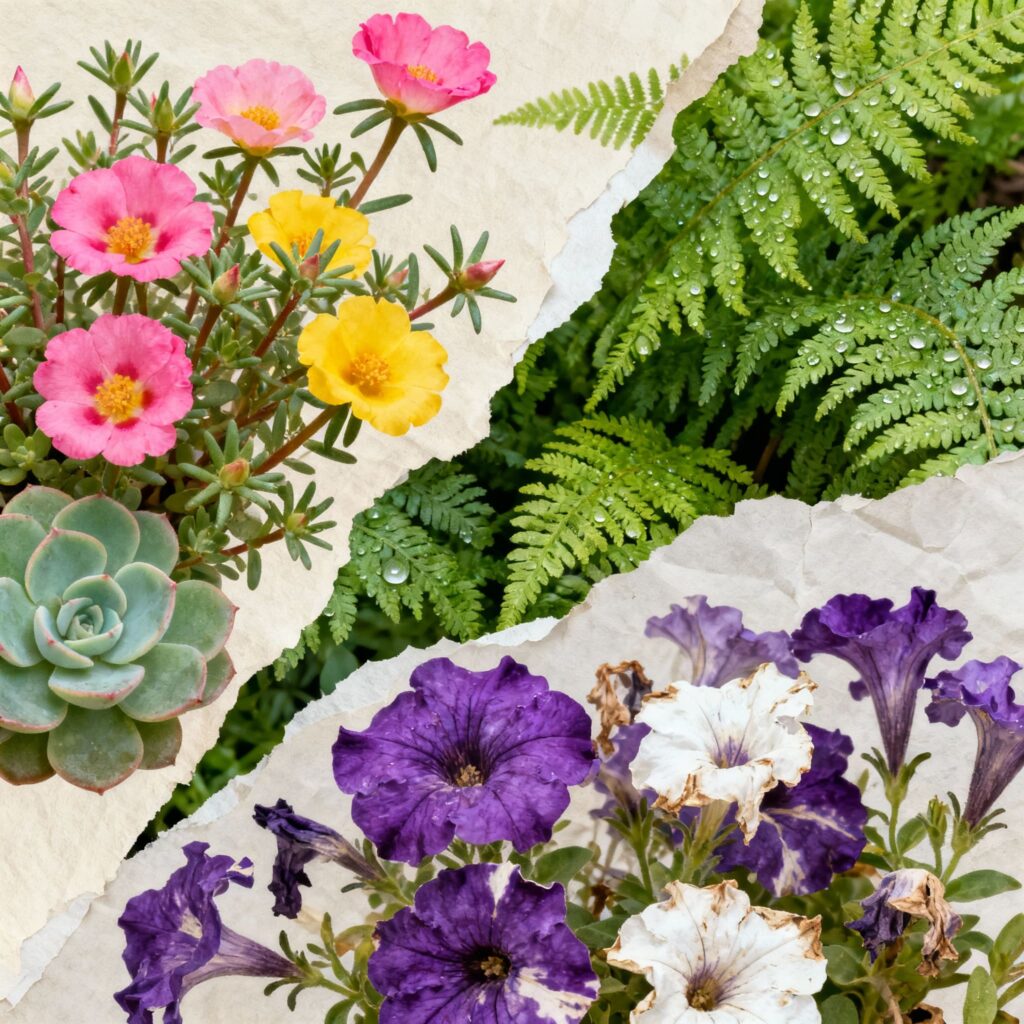
Top 8 Best Plants for Hanging Planters Indoors
After testing over 20 varieties, these eight consistently prove reliable for Indian conditions.
1. Money Plant / Pothos
THE ultimate beginner plant. My first money plant survived bathroom steam, bedroom darkness, travel neglect, and even that time I forgot to water for two weeks. Heart-shaped leaves trail up to 6 feet.
Why it works: Handles a 20-40°C temperature range. Grows in water or soil. Propagates from cuttings easily.
I have five money plants thriving in completely different spots—bathroom (low light), bedroom (medium light), balcony (bright indirect), kitchen window (filtered light), and living room corner (low light).
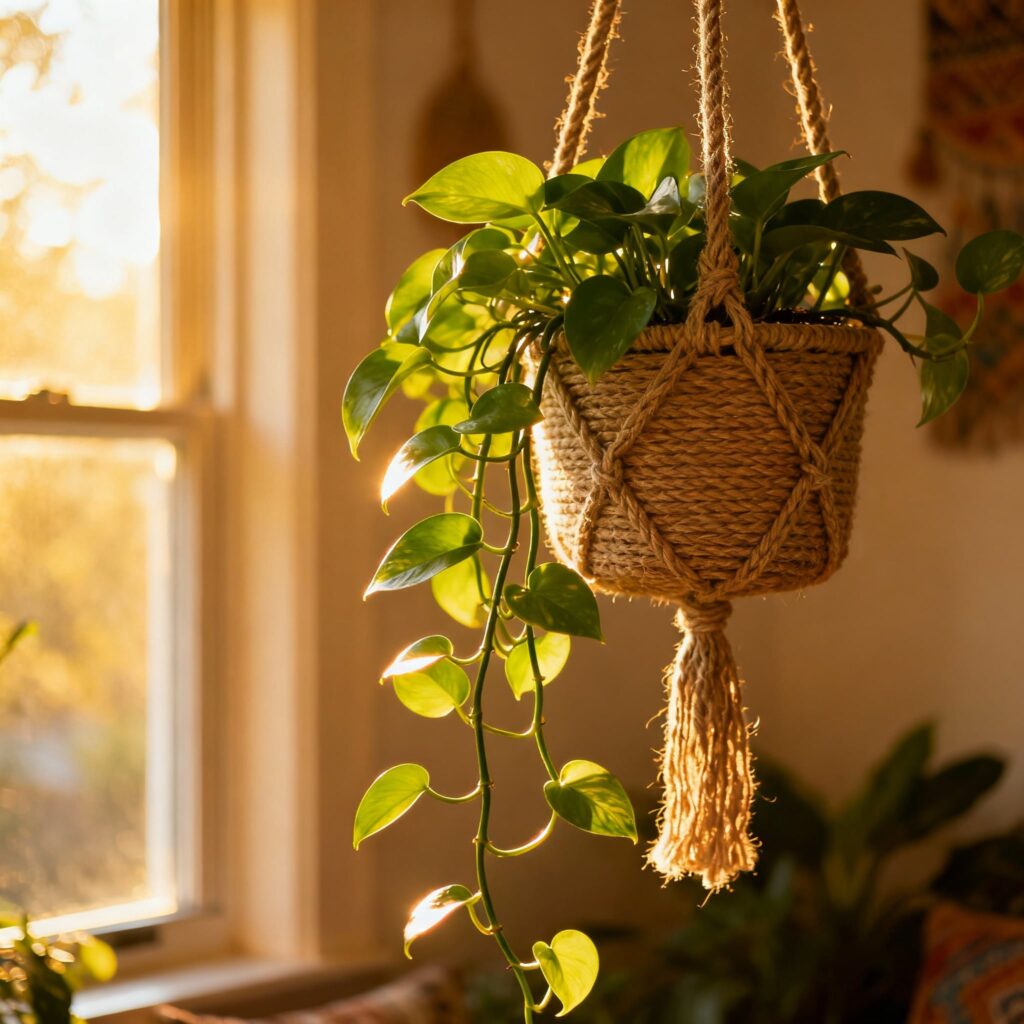
2. Spider Plant
NASA-approved air purifier producing baby plantlets endlessly. White-striped green leaves add wonderful visual interest.
Monsoon bonus: Natural humidity encourages faster growth and more baby plants. I’ve gifted over 30 spider plant pups to neighbors.
Care tip: Use filtered water if tips turn brown—fluoride causes this issue.
3. String of Pearls
Succulent beads cascading like natural jewelry—absolute Instagram gold. Every visitor asks about this plant.
Light requirement: Bright indirect light is crucial. I keep mine where the morning sun hits for 2-3 hours, then shade for the rest.
Where to buy: Ugaoo sells healthy plants for ₹349 on Amazon India.
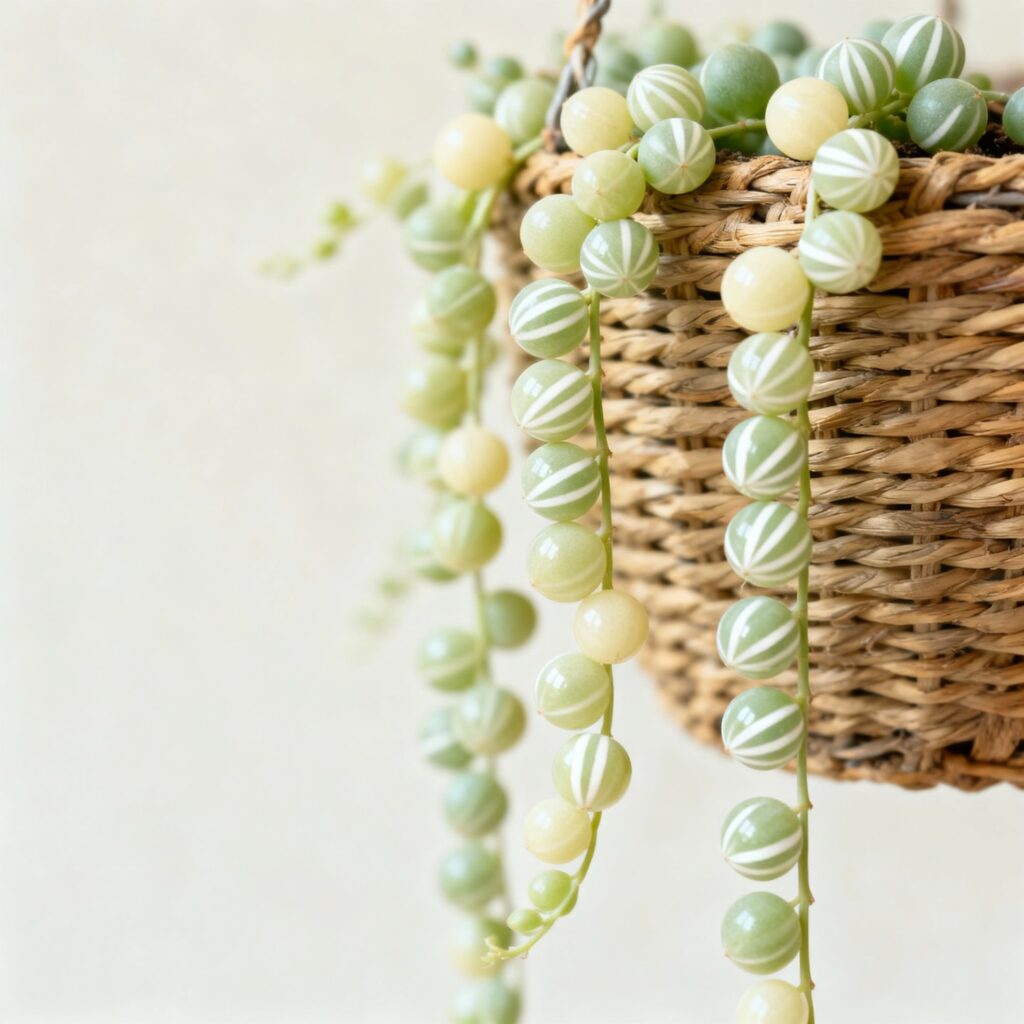
4. Philodendron Heart Leaf
Nearly indestructible with glossy heart-shaped leaves. Tolerates low light better than almost any other trailing variety.
Real test: I placed one in my north-facing bedroom corner with 1-2 hours of indirect light daily. It’s been growing steadily for 18 months.
5. Boston Fern
Lush, tropical fronds create spa vibes. Perfect for bathrooms or humid balconies in coastal cities.
Humidity hack: I hung mine in my bathroom near the window. Natural shower steam provides perfect humidity—no misting needed.
6. English Ivy
Classic cascading vine with lobed leaves. Prefers cooler conditions—excellent for winter or AC rooms.
7. Wandering Jew (Tradescantia)
Purple-green striped foliage grows rapidly and looks stunning against white walls.
Propagation magic: Drop cuttings in water, and roots appear within a week. I’ve created four new plants from one original.
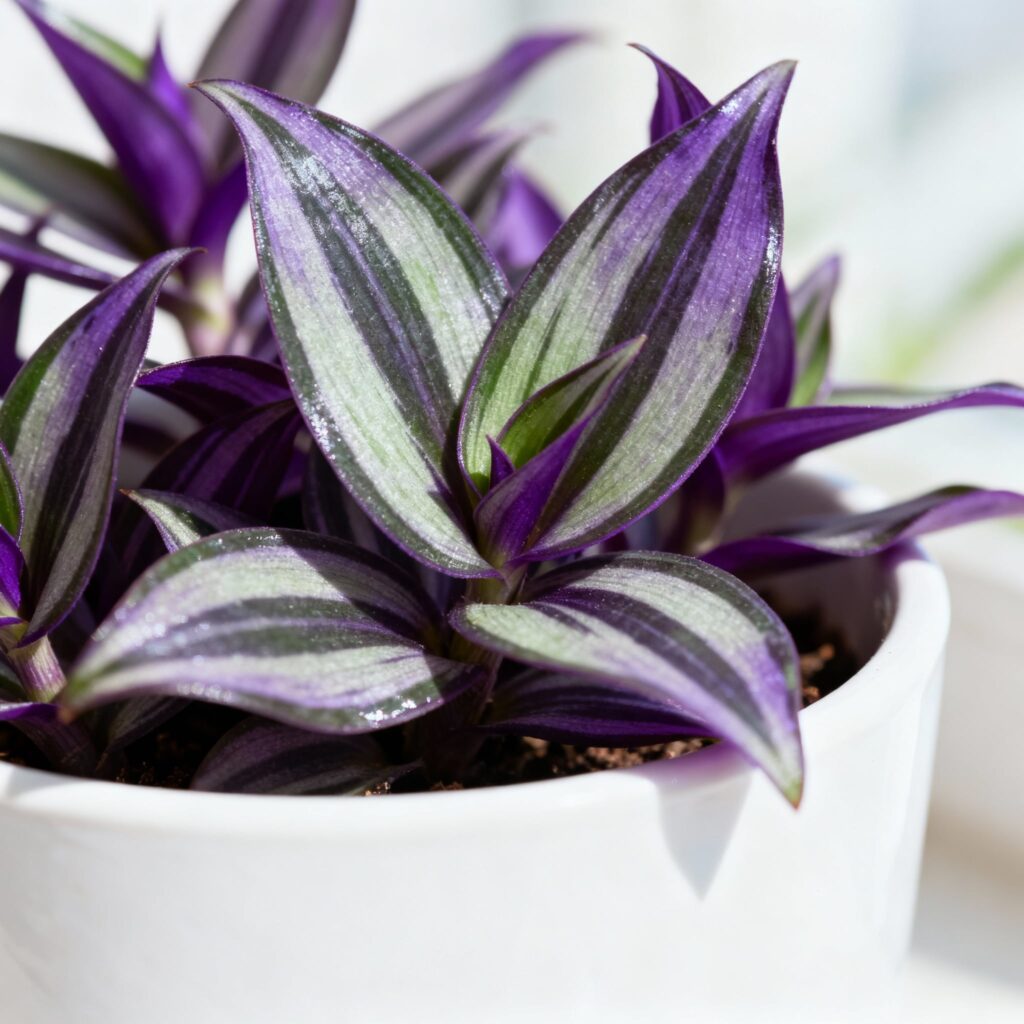
8. Peperomia
Compact with diverse leaf patterns—watermelon, coin-shaped, or rippled varieties. Drought-tolerant and perfect for small spaces.
Best feature: Stays compact (12-18 inches) so it doesn’t overwhelm small apartments.
Combine these plants with ideas from our apartment balcony Indian balcony garden decoration ideas for stunning layered displays.
Hanging Flower Pots with Flowers: Best Blooming Varieties
While foliage plants dominate, several flowering varieties thrive in Indian apartments and bring incredible seasonal color bursts.
Petunia absolutely earns its title as queen of hanging baskets. I planted 10 last October, and they bloomed non-stop from December through March. Available in pink, purple, white, red, and mixed varieties.
Begonia offers delicate flowers and attractive foliage, thriving in partial shade—ideal for north-facing balconies.
Portulaca (Moss Rose) produces cheerful flowers in pink, yellow, orange, and red. Perfect for hot summers and water-wise gardening.
Nasturtium flowers are completely edible, making them unique for kitchen window gardens. Bright orange, red, and yellow blooms trail beautifully.
Fuchsia produces elegant drooping flowers in pink, purple, and white. Prefers cooler temperatures and partial shade.
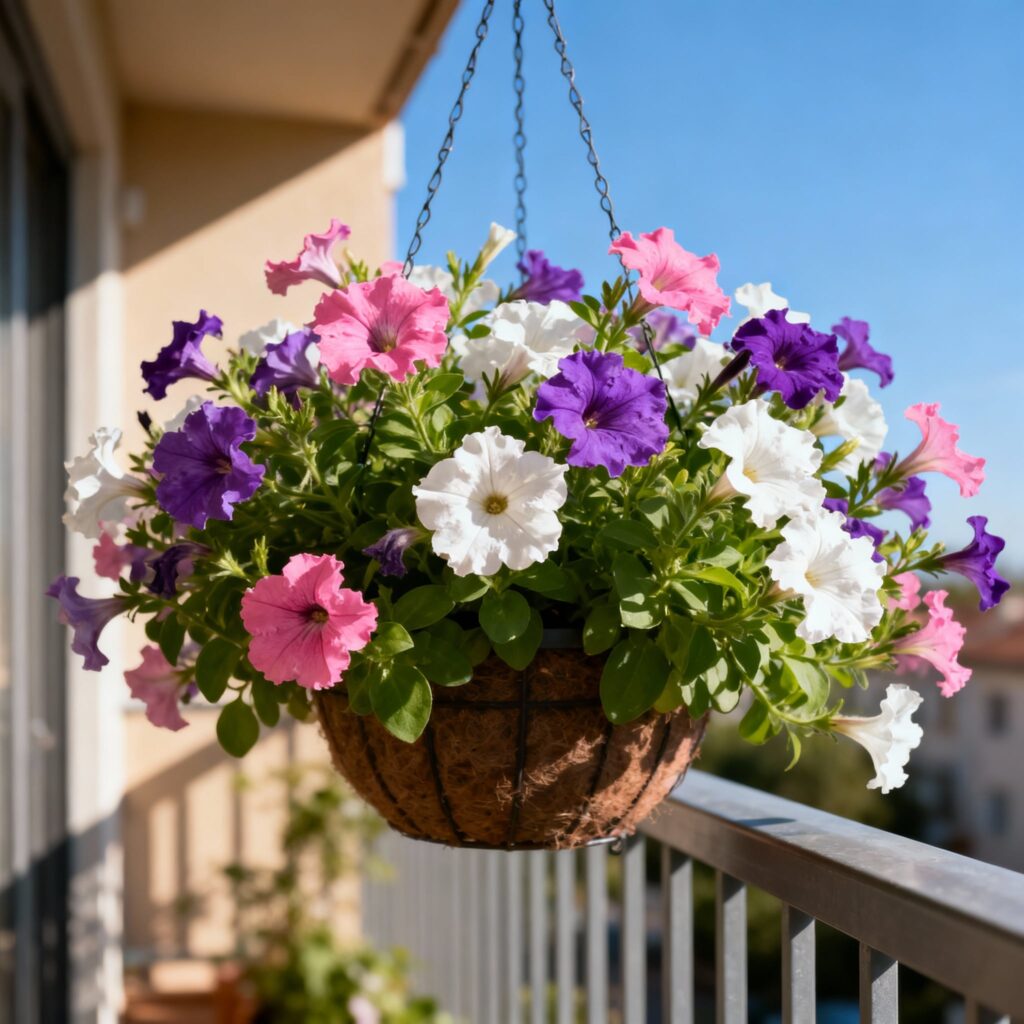
Where to buy: Nurserylive and Ugaoo offer hanging flower pots with flowers combinations starting from ₹299-499.
Care essential: Most flowering plants need 5-6 hours of minimum sunlight daily. Water consistently and deadhead spent flowers regularly for continuous blooms.
Low Maintenance Hanging Plants for Balcony
For busy professionals or frequent travelers, these low maintenance hanging plants for balcony spaces forgive neglect beautifully.
ZZ Plant needs watering just once every 2-3 weeks and survives low light perfectly. My friend’s ZZ plant survived two full weeks of complete neglect during vacation—it’s still thriving.
Snake Plant (Cylindrical varieties) requires only monthly watering and releases oxygen at night. Cylindrical varieties work better in hanging setups.
Syngonium adapts to various light conditions. Water when 50% of the soil feels dry—usually every 4-5 days. Arrow-shaped leaves come in gorgeous pink, white, and green variegations.
Hoyas (Wax Plant) store water in thick leaves, needing watering just every 10-14 days. Mature plants produce fragrant star-shaped flowers that smell amazing.
Pothos remains the classic low-maintenance choice. I’ve seen pothos survive weeks of neglect and bounce back with one good watering.
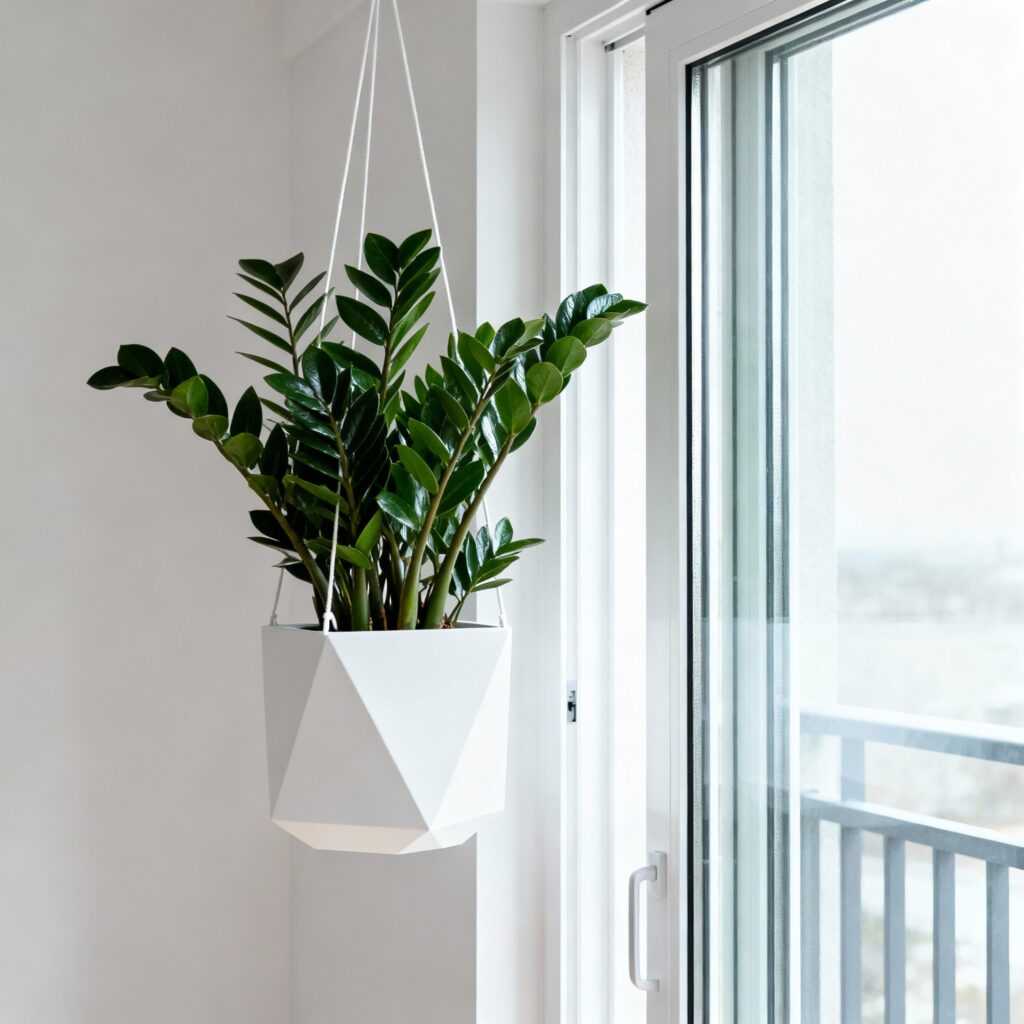
Pair these with easy herbs from our balcony fruit and vegetable garden guide.
Where to buy: Ugaoo offers low maintenance plant combos (₹699 for 3 plants) on Amazon India—perfect starter pack.
Full Sun Hanging Basket Flowers: For Bright Balconies
My south-facing balcony receives 7-8 hours of direct sunlight—perfect for full sun hanging basket flowers.
1. Portulaca (Moss Rose) is my absolute champion. During Delhi’s brutal 42°C May heat, my portulaca bloomed continuously with just once-daily morning watering. No other flowering plant matched that resilience. Available in pink, yellow, orange, and red. Buy: Nurserylive portulaca baskets for ₹299.
2. Petunia — Queen of hanging baskets with prolific blooms. Plant October-November for winter flowers. Buy: Mixed petunia sets cost ₹499 on Amazon India.
3. Verbena produces heat-tolerant purple, pink, and white flower clusters. Once established, surprisingly drought-resistant. I water every other day during peak summer.
4. Marigold (Dwarf Varieties) gives traditional orange/yellow blooms perfect for Diwali. Plant September for October-November flowers.
5. Gazania produces daisy-like flowers in vibrant colors. Extremely heat and drought-tolerant.

Critical care: Full sun hanging basket flowers need daily watering during summer—heat and air circulation dry soil quickly. Self-watering planters make this easier. I switched to self-watering pots, and my morning routine became 10 minutes instead of 30.
Choosing the Right Planter Material for Indian Climate
Planter material significantly impacts plant health and longevity in India’s extreme weather.
Plastic planters are my go-to for outdoor hanging plants. UV-resistant plastic withstands harsh sun, stays lightweight, retains moisture longer, and costs less. My Harshdeep plastic planters have survived three brutal summers without degradation.
Ceramic planters create elegant aesthetics but need indoor placement. They’re heavier (ensure strong hooks), retain moisture well (perfect for ferns), but crack in temperature fluctuations.
Metal planters with coco liners work beautifully for flowering plants. Coconut fiber retains moisture while allowing drainage. Metal handles heat better than ceramic but gets hot in direct sun.
Terracotta and clay provide excellent breathability but are heavy, porous (requiring frequent watering), and crack during seasonal transitions. Better for ground-level than hanging applications.
Wicker and cane baskets create traditional appeal but need plastic liners and degrade faster in monsoon humidity.
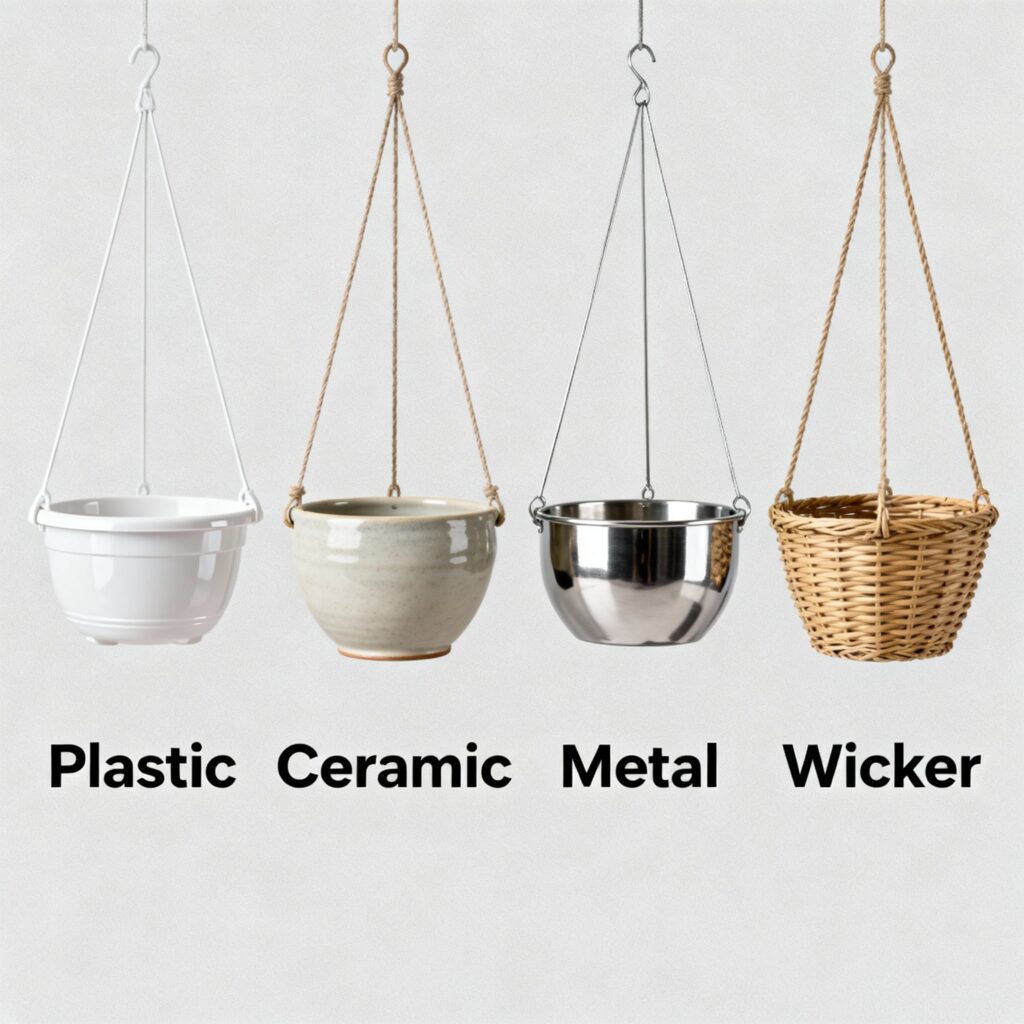
Recommendation: Plastic with drainage holes for outdoor, ceramic for indoor décor, and metal with a coco liner for flowering varieties.
Indoor Hanging Plant Decor Ideas
Styling hanging plants transformed my apartment from “nice plants” to “how did you DO this?”
Corner Cascades changed my living room. I grouped 5 hanging planters at staggered heights in an empty corner. Mixed foliage with flowering plants for color contrast.
Window Frame Gardens using tension rods need zero drilling—perfect for renters. I installed tension rods and hung 4 small planters. The silhouette against natural light looks stunning during golden hour.
Macramé Walls became my feature wall. I displayed 7 macramé hangers in cream jute against my teal wall with brass accessories for a traditional Indian aesthetic. Every visitor photographs this.
Kitchen Herb Curtain makes cooking convenient. I hung basil, mint, and coriander in transparent glass planters near my kitchen window. Snipping fresh herbs while cooking feels special.
Bathroom Spa Vibes came from hanging ferns and spider plants near bathroom windows. Natural humidity eliminates misting. My bathroom feels like a mini tropical spa.
Balcony Ceiling Garden maximizes vertical space. I hung plants at three different levels using varying rope lengths, creating a “green ceiling” effect.
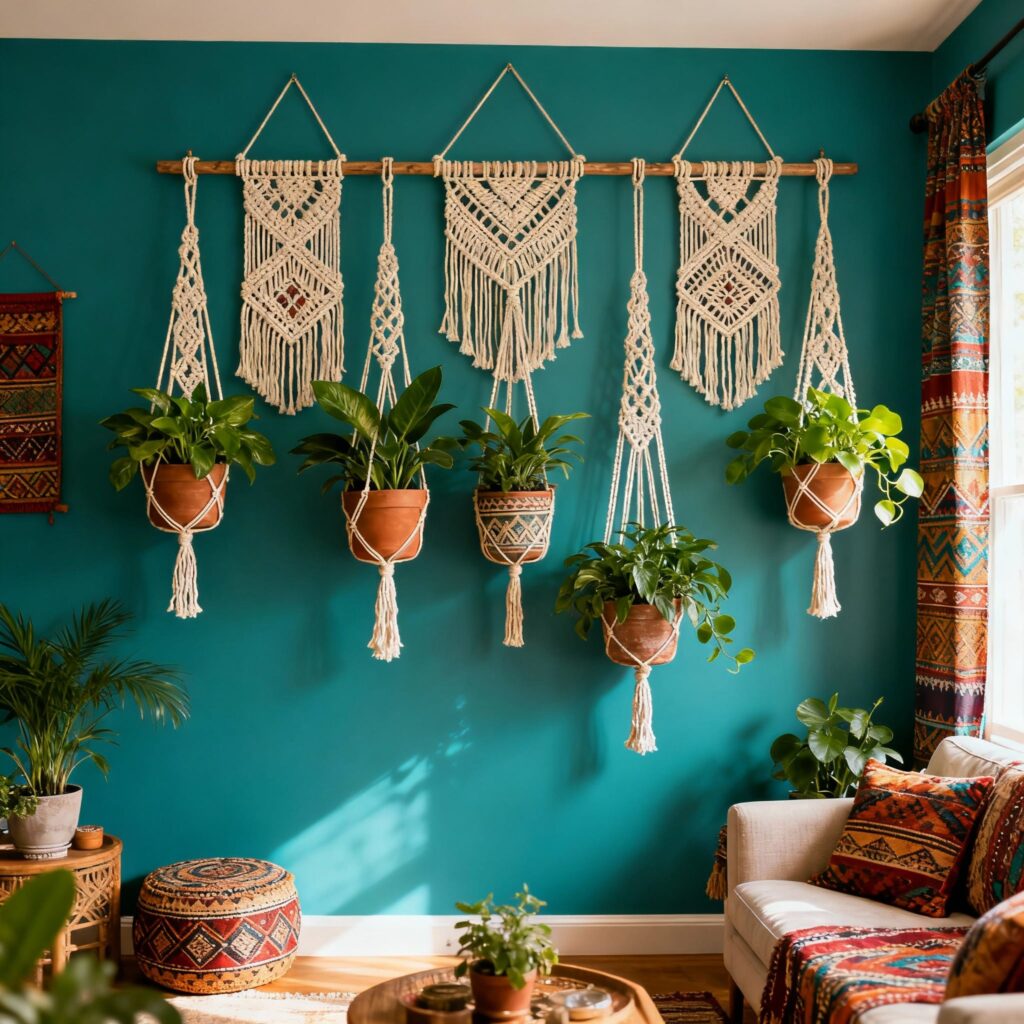
Pro tip: Use matching planter materials for a cohesive look. I switched all living room planters to ceramic white and terracotta. The unified material changed everything.
Common Mistakes to Avoid
Learn from my failures so you don’t repeat them.
Mistake 1: Wrong Hook Weight Capacity
My first hanging planter crashed at 2 AM because I used cheap adhesive hooks. Hanging planters weigh 5-10 kg.
Solution: Use ceiling hooks rated for 10+ kg minimum. This ₹200 investment saves crashed plants and damaged floors.
Mistake 2: No Drainage Holes
The #1 killer of hanging plants. Waterlogging causes root rot. I lost my first three plants to this.
Fix: Drill 3-4 holes (5-7mm diameter) in bottoms. Add 1-inch pebble layer before soil.
Mistake 3: Overwatering During Monsoon
I killed three spider plants during my first monsoon by maintaining summer watering. Monsoon humidity keeps soil moist naturally.
Current system: Check soil moisture before EVERY watering. Finger 2 inches deep—if damp, skip watering. This brought my survival rate to 100%.
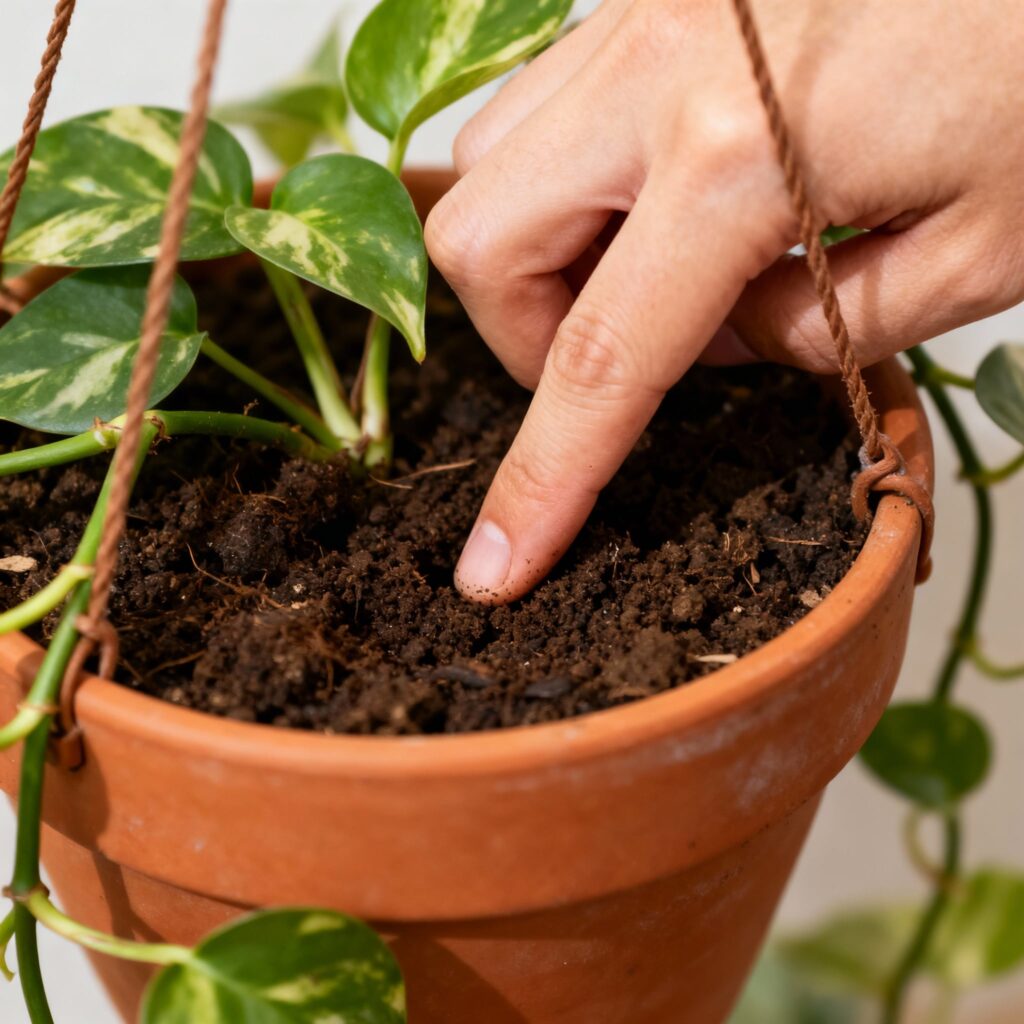
Mistake 4: Using Heavy Garden Soil
Regular soil becomes cement-like in hanging planters.
Better option: Lightweight mix—cocopeat + vermicompost + perlite (2:1:1). 5kg bag lasts 15-20 planters, costs under ₹300.
Mistake 5: Hanging Too High
Out of sight equals out of mind. My ceiling planter (8 feet high) died from neglect.
Practical height: Maximum arm’s reach—6-7 feet. Easy watering without equipment.
Mistake 6: Ignoring Plant-Light Mismatch
Sun-loving portulacas die in bathrooms. Shade-loving ferns burn on sunny balconies.
Match correctly: Observe light conditions one full day before buying. Morning sun (6-10 AM) is gentle. Afternoon sun (12-4 PM) is intense—only full-sun plants survive.
Care Tips for Indian Climate
Monsoon (June-September): Reduce watering by 60-70%. Apply neem oil spray (5ml per liter) every 10 days to prevent fungal issues. Keep spray bottle pre-mixed and ready.
Summer (March-June): Daily watering for full-sun plants, twice-weekly for shade varieties. Mist ferns/begonias at 4-5 PM to combat dry heat.
Winter (October-February): Water every 4-5 days. Mist twice weekly when heaters reduce humidity below 30%. Move cold-sensitive plants from windows during December-January nights below 10°C.
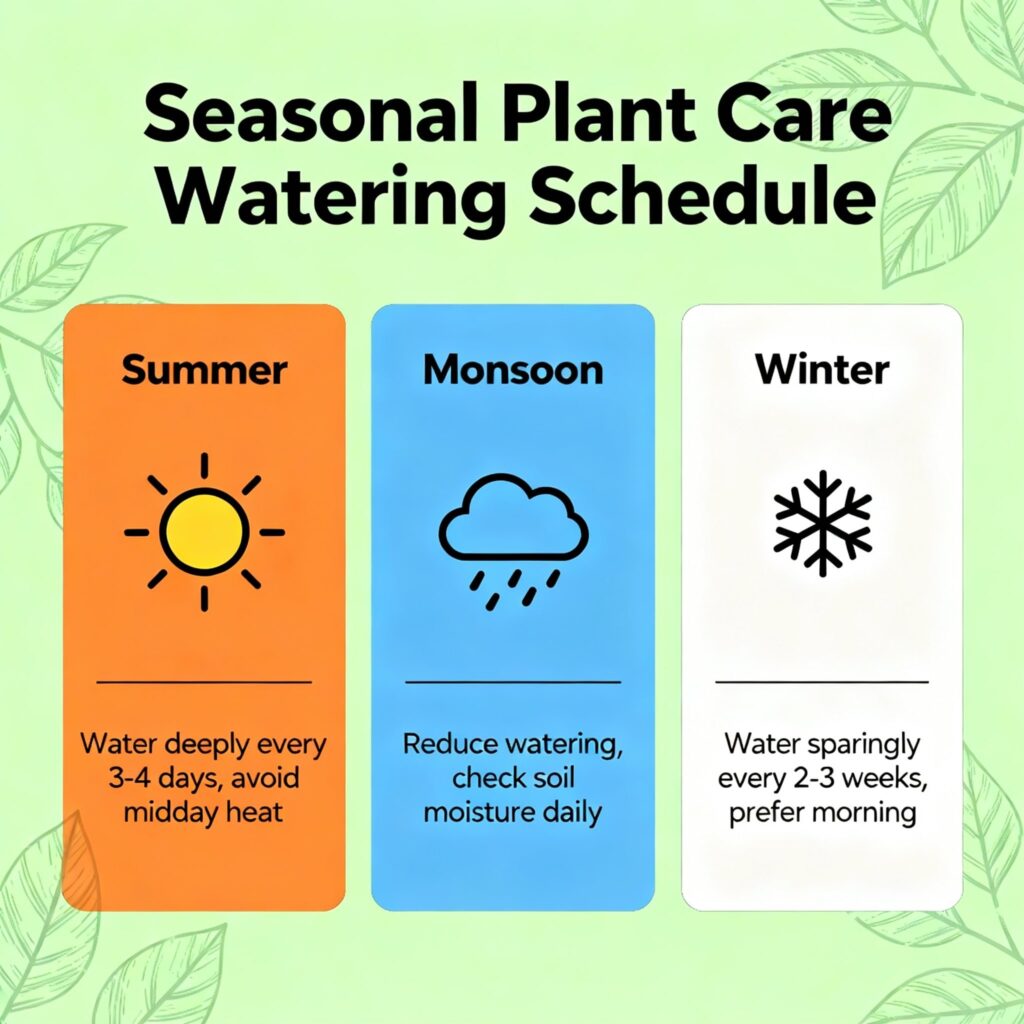
Fertilizing: Liquid fertilizer at half-strength monthly during March-May and September-November. Skip during monsoon. I use balanced NPK (19:19:19) diluted to half strength.
Soil check: Best mix—cocopeat + vermicompost + perlite (2:1:1). Replace topsoil every 8-10 months.
For outdoor vertical gardening, explore our raised garden bed apartment balcony solutions.
Best Indoor Hanging Planters to Buy (2025)
💡 Affiliate Disclosure:
FlatGardening.com earns commissions from qualifying Amazon India purchases at no extra cost to you. Recommendations based on personal testing and community reviews.
| Product | Material | Best For | Price | Where to Buy |
|---|---|---|---|---|
| Harshdeep Capri Plastic (Set of 3) | UV-resistant plastic | Budget beginners, sunny balconies | ₹399 | 👉 Check on Amazon India |
| Ugaoo Ceramic with Macramé | Ceramic + jute rope | Boho living room décor | ₹799 | 👉 View on Amazon India |
| Nurserylive Self-Watering Pot | Plastic with reservoir | Travelers, forgetful waterers | ₹649 | 👉 Shop on Nurserylive |
| Plastic with a reservoir | Metal + coco liner | Flowering plants, outdoor | ₹499 | 👉 Get on Amazon India |
| Fourwalls Wicker Basket | Cane + plastic liner | Traditional décor, indoors | ₹449 | 👉 Buy on Amazon India |
Personal recommendation: Nurserylive self-watering pots for balcony plants. A 7-day water reservoir means once-weekly watering even in peak summer. Worth the extra ₹150-200.
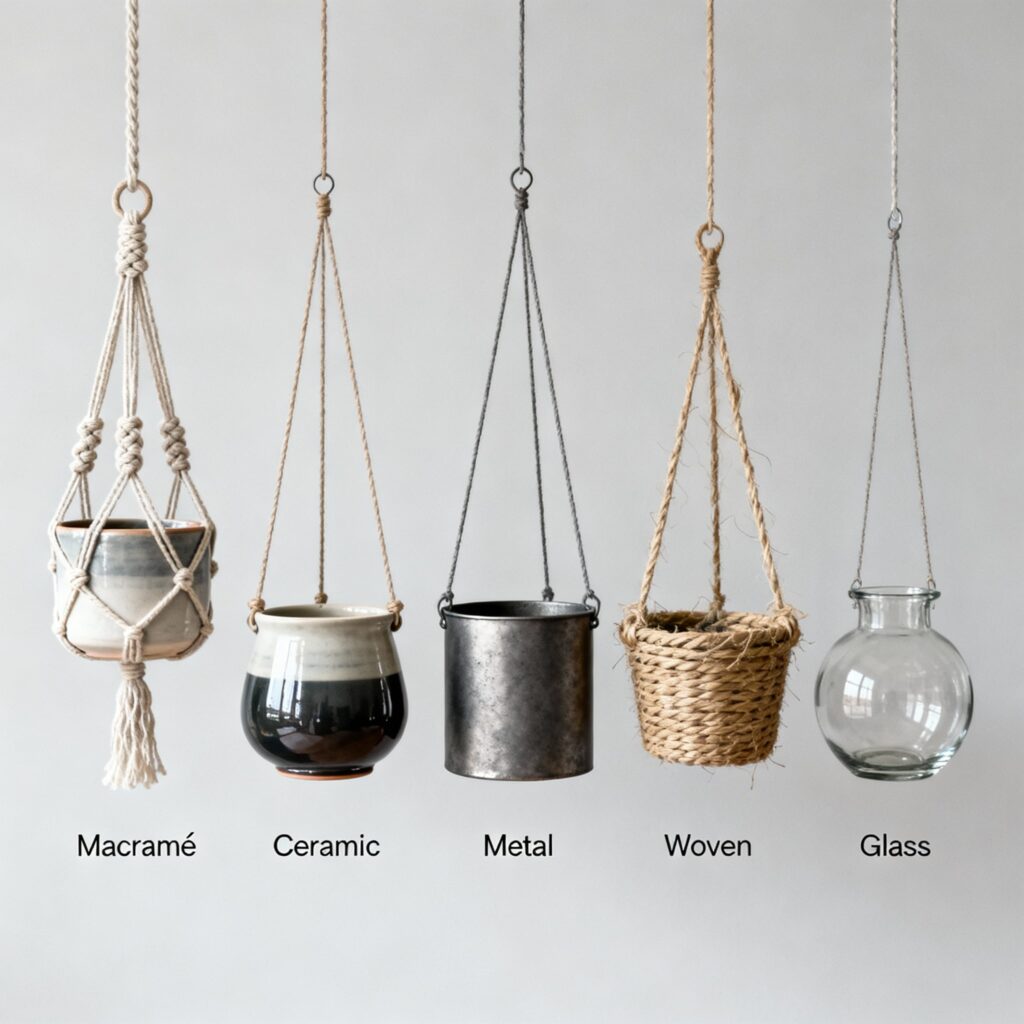
Air-Purifying Indoor Hanging Plants
Spider Plant — NASA-approved for removing formaldehyde, xylene, and toluene. Produces baby plantlets.
English Ivy — Removes airborne particles and formaldehyde. Perfect for bathrooms.
Boston Fern — Natural humidifier removing formaldehyde and xylene. Adds moisture to dry air.
Pothos/Money Plant — Removes benzene, formaldehyde, xylene, toluene. Works in any light.
According to NASA’s Clean Air Study, these significantly improve indoor air quality. Place 2-3 in bedrooms and living rooms for noticeable improvement.
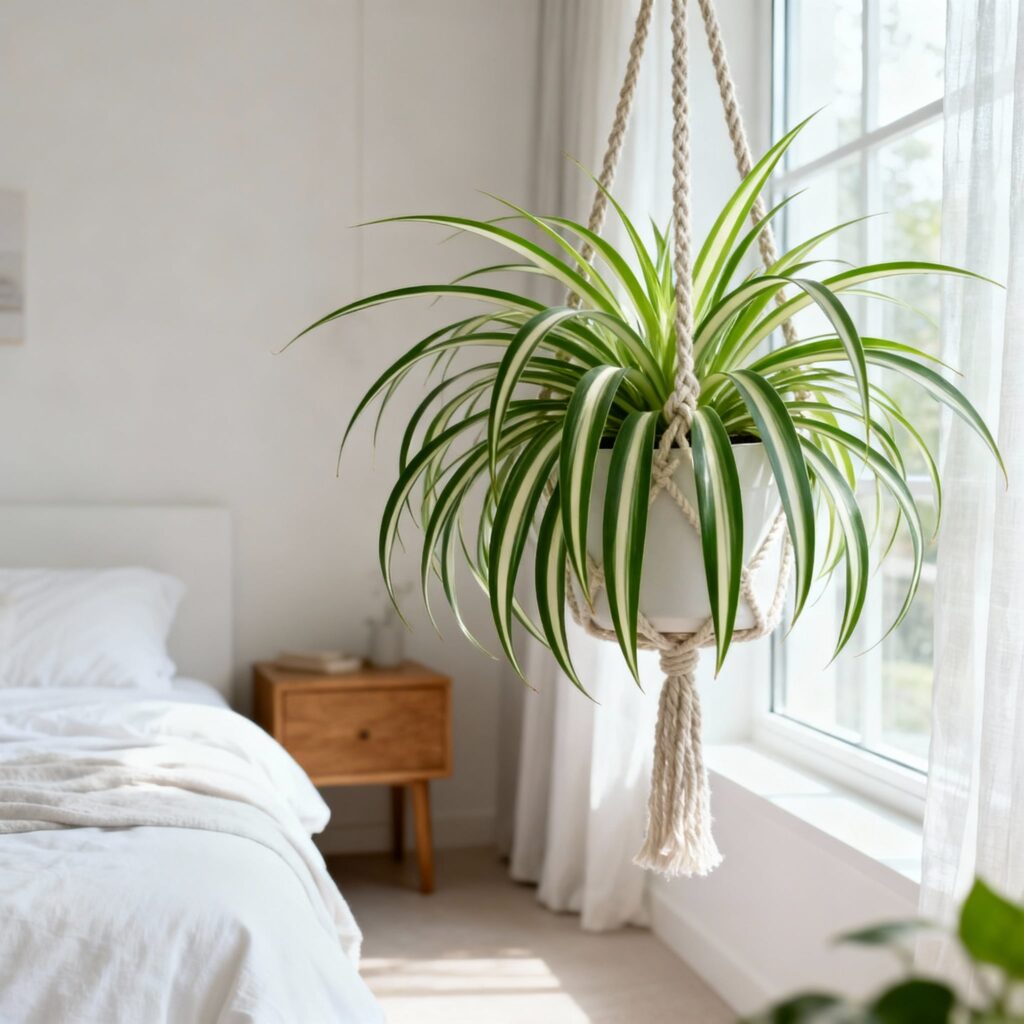
Quick Recap: Your Cheat Sheet
- Best summer plant: Portulaca (blooms in 40°C+ heat)
- Best low-light: Pothos (survives 2 hours of indirect light)
- Best air purifier: Spider Plant (NASA-approved)
- Best low-maintenance: ZZ Plant (water every 2-3 weeks)
- Best for monsoon: Boston Fern (thrives in 70%+ humidity)
- Best flowering: Petunia (blooms October-March)
- Best planter: Plastic for outdoor, ceramic for indoor
- Critical tip: Check soil moisture before watering
Conclusion: Start Your Journey Today
Indoor hanging plants transformed my cramped Mumbai apartment into a lush vertical garden without sacrificing floor space.
From foolproof pothos to vibrant petunias, there’s a perfect plant for every condition and maintenance level.
Start with one easy-care variety this weekend. Within a week, you’ll notice how differently your home feels—fresher air, more alive, more peaceful.
Remember: matching plants to Indian seasonal conditions, especially monsoon adjustments, makes the difference between barely surviving and absolutely thriving plants.
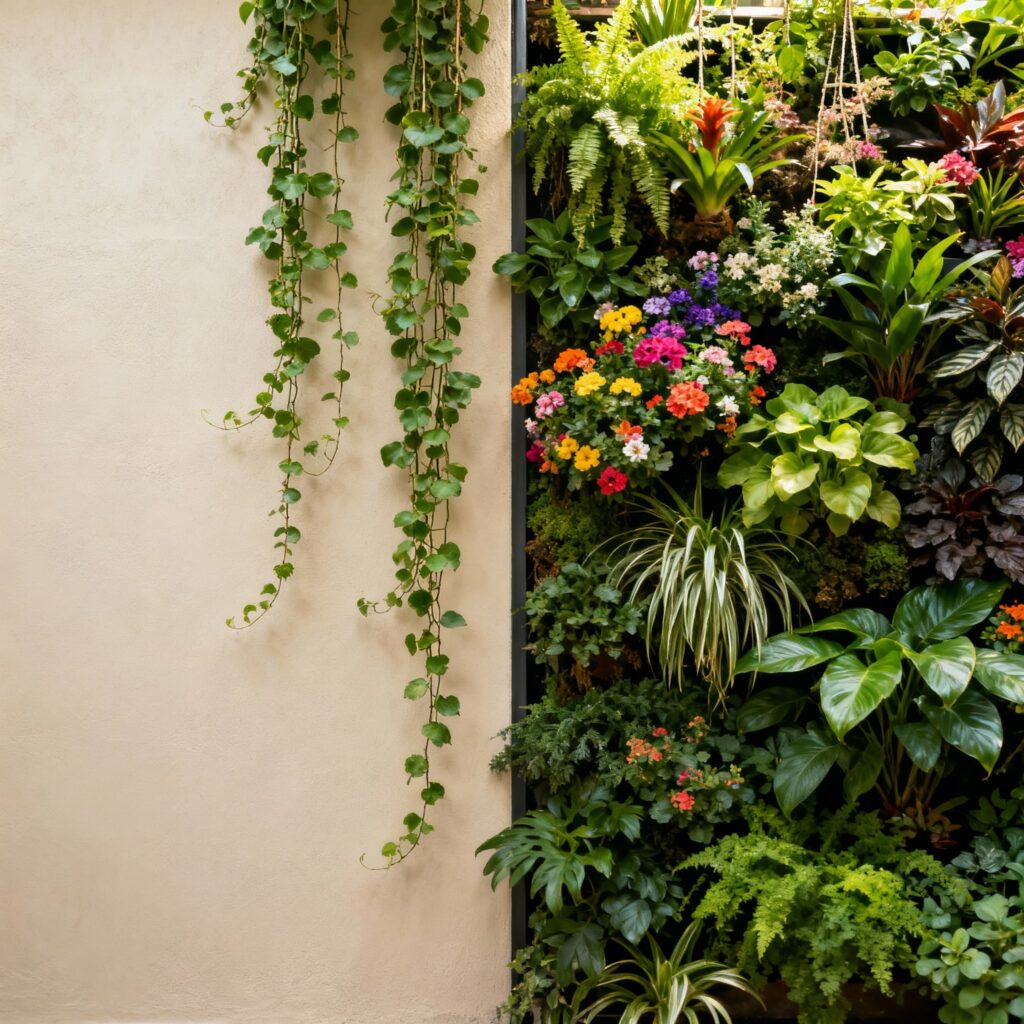
Your turn: Pick your first hanging plant this weekend. Take a before photo. Plant it. Care for it using these seasonal tips. Then take an after photo in one month and tag @FlatGardening on Instagram—let’s build India’s most inspiring apartment garden community!
The wall you’re staring at right now? It could be cascading with green within one month. Start today.
💬 Which hanging plant are you most excited to try? Comment below—I reply personally to every question!
Frequently Asked Questions
Q: Which indoor plants grow best in hanging pots?
A: Money plant (pothos), spider plant, philodendron, string of pearls, and Boston fern are the best plants for hanging planters indoors for Indian apartments. These trail naturally, tolerate varying light from bright indirect to low light, and forgive occasional missed waterings. For absolute beginners, pothos is most forgiving—survives bathroom humidity, bedroom darkness, irregular watering, and even two-week vacation neglect.
Q: How often should I water indoor hanging plants in India?
A: Watering varies by season. Summer (March-June): Daily for full-sun plants, every 2-3 days for shade. Monsoon (June-September): Reduce by 60-70%—once every 7-10 days because humidity keeps soil moist. Winter (October-February): Every 4-5 days. Always check soil moisture by finger 2 inches deep—water only when dry. This prevents 80% of overwatering deaths.
Q: What are common mistakes with hanging plants?
A: Biggest mistakes include overwatering during monsoon (causes root rot), using planters without drainage holes, hanging too high to maintain, mismatching plant light needs with placement, using heavy garden soil instead of lightweight potting mix, and underestimating the weight load on hooks. Checking soil moisture before every watering prevents 80% of problems.
Q: Which hanging plants need full sun on Indian balconies?
A: Portulaca, petunia, verbena, marigold, and gazania thrive in 6-8 hours direct sunlight on south/west-facing balconies. These full sun hanging basket flowers need intense sun to bloom profusely. Portulaca is most heat-tolerant—blooms even during 40°C+ days in Delhi and Pune. These need daily watering during summer.
Q: How do I prevent pests in hanging plants during the monsoon?
A: Ensure excellent drainage, allow topsoil to dry between waterings, spray diluted neem oil (5ml per liter) every 7-10 days, sprinkle cinnamon powder as a natural antifungal, increase air circulation, and remove yellowing leaves promptly. These practices kept my 15-plant hanging garden pest-free through two Mumbai monsoons.
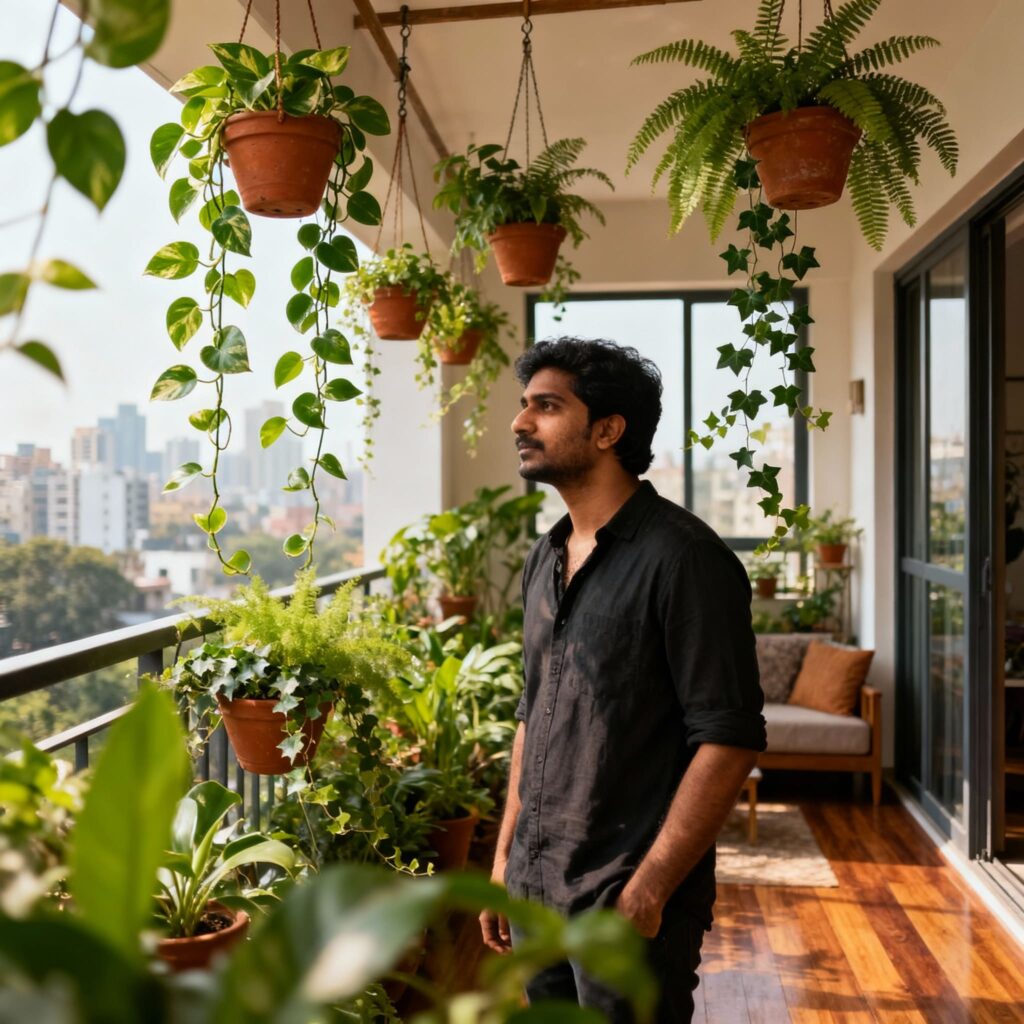
About the Author
Zaid Ansari is the founder of FlatGardening.com, passionate about vertical gardening and balcony décor for Indian homes.
After transforming his 650 sq ft Mumbai flat into a thriving 40-plant garden, he shares practical, climate-tested advice that works in real Indian apartments—from monsoon care to summer survival.
FlatGardening helps apartment dwellers create beautiful, productive green spaces regardless of size limitations, with beginner-friendly guidance and realistic expectations.